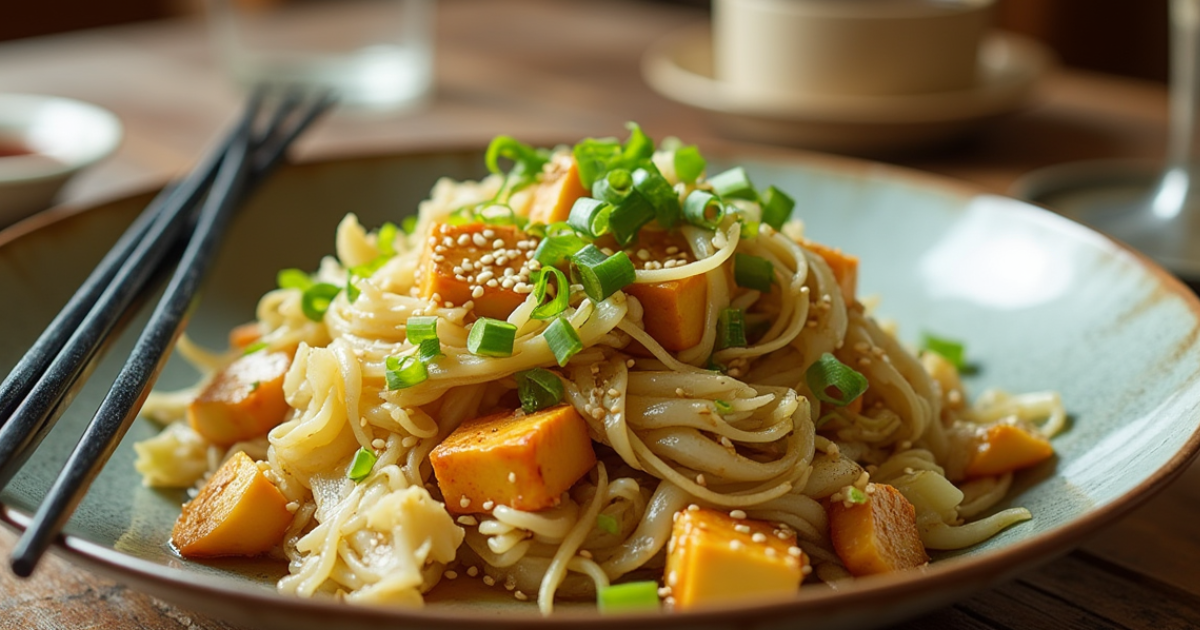Table of Contents
Table of Contents
Introduction
Napa cabbage sits quietly in produce sections across America, often overlooked despite its incredible versatility. This leafy vegetable, with its crinkled leaves and crisp texture, transforms ordinary meals into extraordinary culinary experiences.
Originally from China, where it’s known as Chinese cabbage, napa cabbage recipes has been a staple in Asian cuisine for centuries. Dating back to the 15th century, farmers in the Yangtze River region cultivated this vegetable for its sweet flavor and tender texture. The name “napa” doesn’t refer to California’s wine country but comes from the Japanese term “nappa,” meaning leafy green.
What makes napa cabbage stand out from regular cabbage or bok choy is its nutritional profile. Packed with vitamins A, C, and K, plus a good dose of calcium and potassium, napa cabbage offers more nutrients than green cabbage while containing fewer calories. Its mild flavor makes it perfect for both raw applications in salads and cooked dishes like stir-fries, soups, and the famous Korean kimchi.
Ingredients Napa Cabbage Recipes
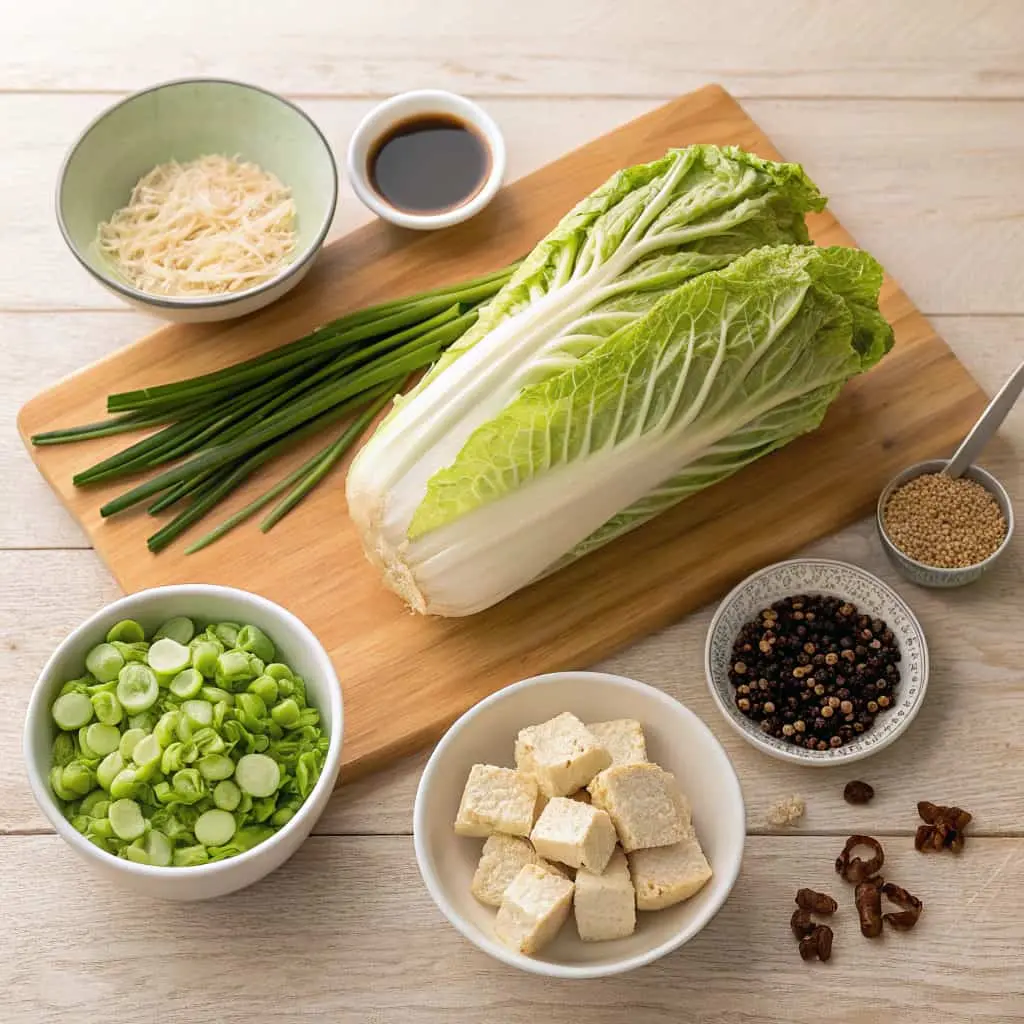
Main Ingredients
- 1 medium napa cabbage (about 2 pounds)
- 3 tablespoons soy sauce
- 2 tablespoons sesame oil
- 1 tablespoon rice vinegar
- 2 cloves garlic, minced
- 1 tablespoon fresh ginger, grated
- 2 green onions, sliced
- 1 tablespoon sesame seeds
- 1 teaspoon black pepper
- 1 tablespoon vegetable oil for cooking
Ingredient Substitutions
Vegan Alternative
This recipe is naturally vegan. For added protein, include:
- 8 ounces firm tofu, cubed and pressed
- 1 cup edamame, shelled
Gluten-Free Option
- Replace soy sauce with tamari or coconut aminos
- Ensure any additional seasonings are certified gluten-free
Other Dietary Alternatives
- Low-sodium version: Reduce soy sauce to 1 tablespoon and add 1/4 teaspoon salt
- Spicy version: Add 1 tablespoon chili paste or 1 teaspoon red pepper flakes
- Oil-free option: Replace oils with vegetable broth for sautéing
How to Make Napa Cabbage Recipes
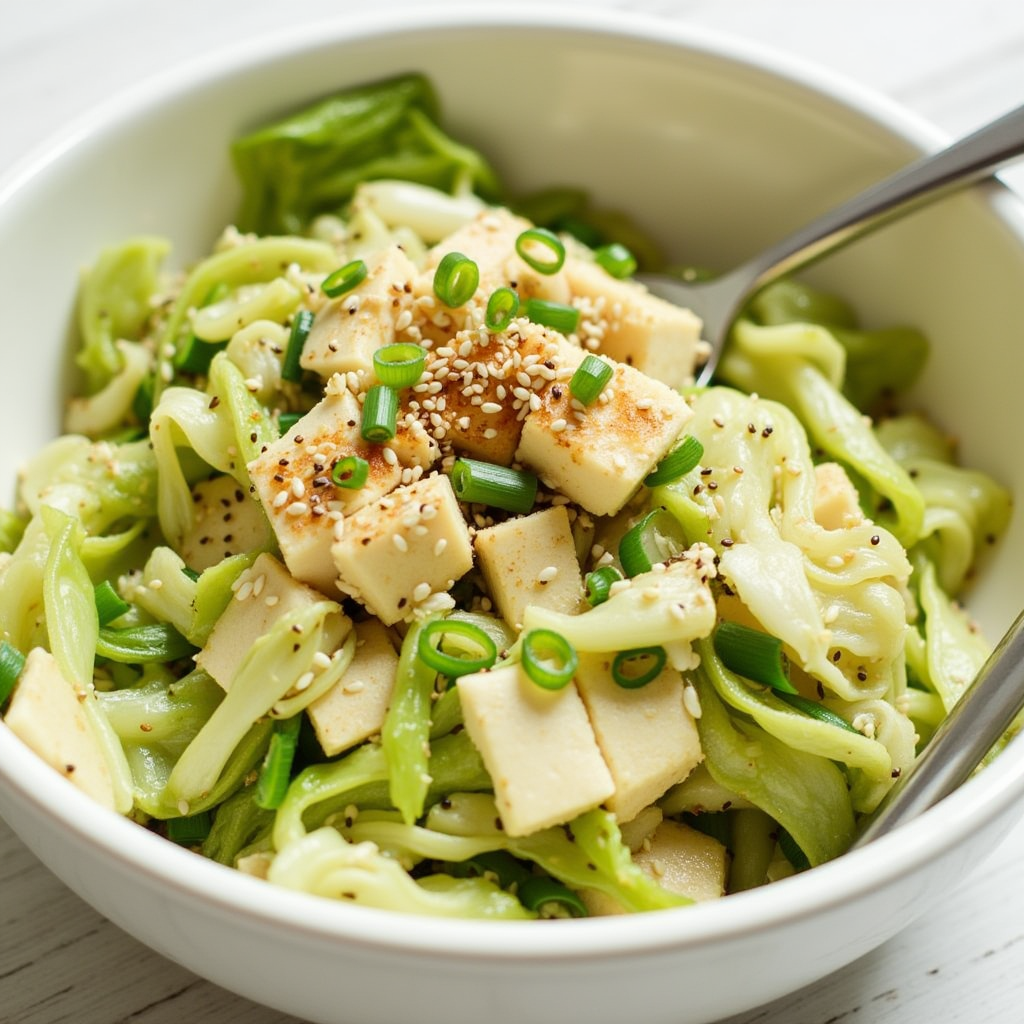
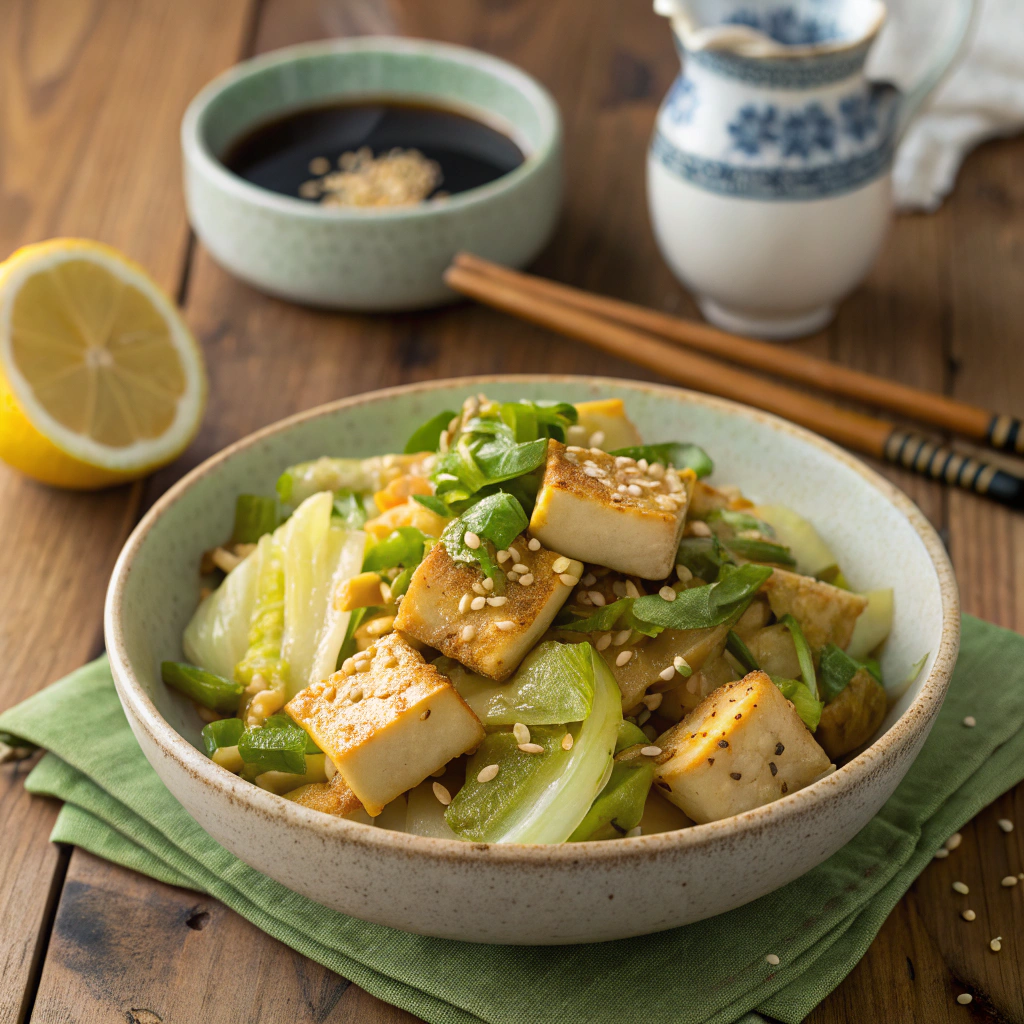
Step 1: Preparing the Ingredients
- Cut the napa cabbage in half lengthwise, then remove the core.
- Slice the cabbage into 1-inch strips crosswise. Rinse thoroughly under cold water and drain well.
- Mix the sauce ingredients in a small bowl: soy sauce, sesame oil, rice vinegar, minced garlic, and grated ginger. Set aside.
- If using tofu, press it between paper towels to remove excess moisture, then cut into 1/2-inch cubes.
- Slice green onions, separating white and green parts.
The key to prep is making sure your cabbage is dry after washing. Excess water will make your dish soggy instead of crisp, (source: Serious Eats).
Step 2: Cooking Process
- Heat vegetable oil in a large wok or skillet over medium-high heat.
- Add the white parts of green onions and cook for 30 seconds until fragrant.
- For the tofu option, add tofu cubes now and cook until golden, about 3-4 minutes.
- Add the napa cabbage to the pan. Stir-fry for 2-3 minutes until it begins to wilt but still maintains some crunch.
- Pour the sauce mixture over the cabbage and toss to coat evenly.
- Cook for another 2-3 minutes, stirring frequently.
The cooking time for napa cabbage is shorter than regular cabbage. Watch carefully to avoid overcooking.
Step 3: Final Touches & Serving
- Remove from heat and sprinkle with black pepper, sesame seeds, and the green parts of the onions.
- Toss once more to distribute the garnishes.
- Transfer to a serving dish immediately.
- For a nice presentation, serve with lemon wedges and additional sesame seeds.
This dish is best served hot, but it also tastes great at room temperature as a side dish.
Tips & Variations
Flavor Enhancements
- Add 1 tablespoon of rice wine for an authentic Asian flavor
- Mix in 1 teaspoon of honey to balance the saltiness of soy sauce
- Include 1 tablespoon of miso paste for depth
- Try adding a splash of fish sauce for a Thai-inspired version
Texture Modifications
- For extra crunch, add water chestnuts or chopped peanuts
- For a softer texture, cook the cabbage longer (5-7 minutes)
- Create cabbage wedges instead of strips for a different presentation
- Shred very finely for a cabbage slaw texture
Serving Suggestions
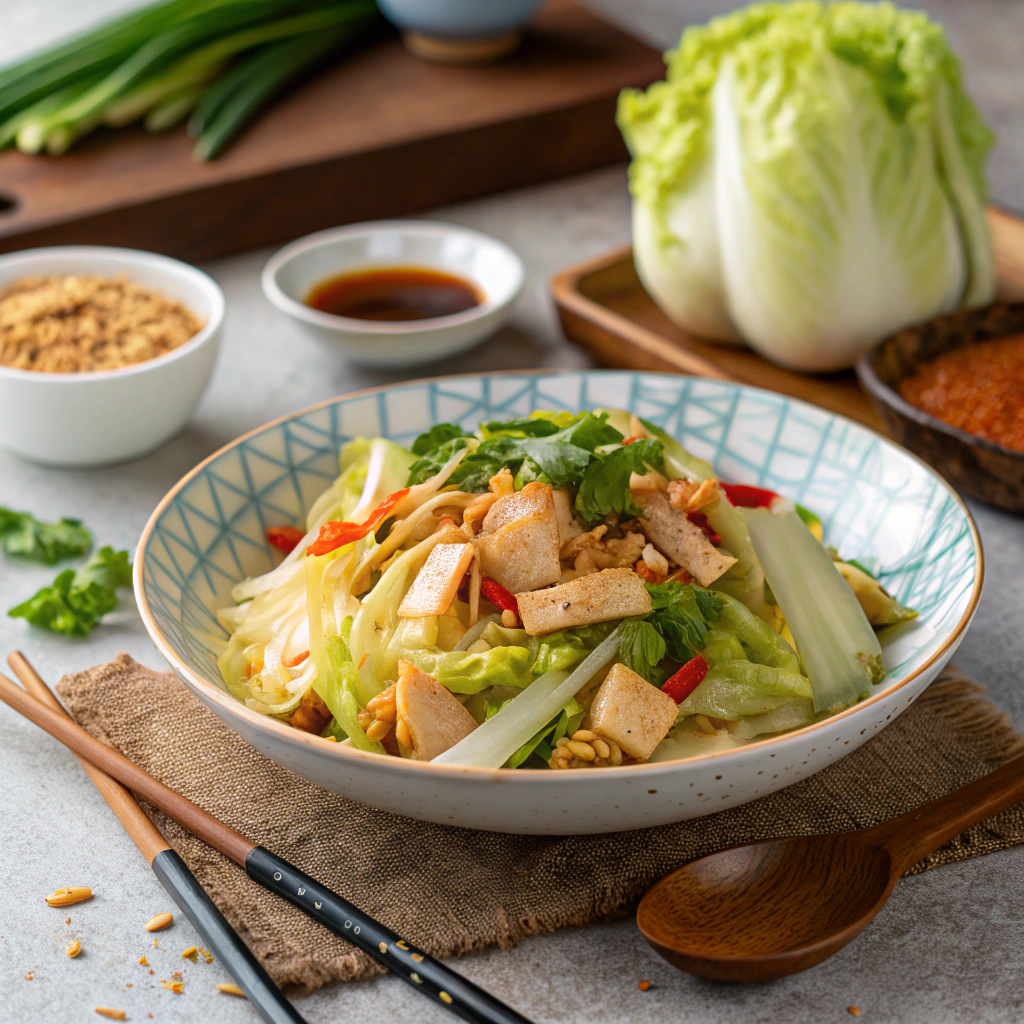
- Pair with steamed rice for a complete meal
- Serve alongside grilled fish or chicken
- Use as a base for grain bowls
- Wrap in rice paper with herbs for fresh spring rolls
- Mix with cooked noodles for a quick noodle dish
Nutritional Information
Nutritional Value Per Serving
(Based on recipe serving 4 people)
- Calories: 120
- Protein: 3g
- Fat: 9g
- Carbohydrates: 8g
- Fiber: 3g
- Sugar: 2g
- Sodium: 540mg
Health Benefits
- Napa cabbage provides vitamin C, supporting immune function
- Sesame oil contains heart-healthy unsaturated fats
- Ginger aids digestion and has anti-inflammatory properties
- Garlic has antimicrobial benefits and may help lower blood pressure
- The dish is low in calories while providing satisfying volume
- High water and fiber content aids hydration and digestion
Common Mistakes & Fixes
Issue 1: Soggy Cabbage
Problem: Cabbage releases too much water and becomes mushy. Fix: Make sure to dry the cabbage well after washing. Cook on high heat quickly rather than slow cooking. Don’t cover the pan during cooking.
Issue 2: Too Salty
Problem: The dish tastes overwhelmingly salty. Fix: Reduce soy sauce amount and balance with more rice vinegar. Add a squeeze of lemon juice to brighten flavors without adding salt. Serve with plain rice to offset saltiness.
Issue 3: Bland Flavor
Problem: The dish lacks depth and tastes flat. Fix: Toast sesame seeds before adding them. Make sure to use fresh ginger and garlic, not pre-minced. Add a dash of rice wine or mirin. Consider using roasted sesame oil rather than regular for more impact.
FAQs
How can I store this recipe?
Store leftover napa cabbage stir-fry in an airtight container in the refrigerator for up to 3 days. The flavor often improves overnight as ingredients meld together. Reheat gently in a pan with a splash of water, or enjoy cold as a salad.
Can I prepare it in advance?
You can prep all ingredients up to 24 hours ahead. Slice the cabbage, make the sauce, and store separately in the refrigerator. The actual cooking takes less than 10 minutes, making this ideal for quick meals. Avoid cooking the entire dish ahead as napa cabbage is best when freshly cooked.
What are the best add-ons for this recipe?
The best add-ons include protein sources like thinly sliced beef, chicken, or shrimp. For vegetarians, mushrooms (shiitake or oyster) add meaty texture. Other vegetables that pair well include carrots, bell peppers, and snow peas. For added crunch, try water chestnuts or bamboo shoots.
What is the best way to eat napa cabbage?
Napa cabbage shines in multiple preparations. Raw, it makes excellent salads and slaws with a milder flavor than regular cabbage. When cooked, quick-cooking methods like stir-frying preserve its texture and nutrients. It’s also excellent in soups, dumplings, and fermented dishes like kimchi. Its versatility allows it to absorb flavors while maintaining structural integrity.
Is napa cabbage the same as kimchi?
No, napa cabbage is not the same as kimchi. Napa cabbage is a fresh vegetable, while kimchi is a traditional Korean fermented food often made using napa cabbage as the main ingredient. Kimchi includes napa cabbage plus seasonings like chili powder, garlic, ginger, and fish sauce, which is then fermented. Think of the relationship like cucumbers to pickles.
Is it OK to eat Napa cabbage raw?
Yes, napa cabbage is perfectly safe and delicious to eat raw. In fact, its crisp texture and mild, slightly sweet flavor make it ideal for fresh applications. Use it in salads, slaws, wraps, or as a lettuce substitute. The outer leaves tend to be tougher, while the inner leaves are more tender, similar to lettuce hearts.
Conclusion & Call to Action
Napa cabbage deserves a prime spot in your cooking rotation. Its versatility spans cuisines from East to West, while its nutritional profile makes it a smart choice for health-conscious cooks. The recipes shared here merely scratch the surface of what’s possible with this remarkable vegetable.
We’d love to hear how these napa cabbage recipes worked for you. Did you try any variations? Share your experiences in the comments below. Your feedback helps fellow food enthusiasts discover new ways to enjoy this versatile vegetable.
Looking for more Asian-inspired dishes? Check out our related recipes for Quick Bok Choy Stir-Fry, Simple Tofu with Vegetables, or our guide to making Homemade Kimchi. Each recipe builds on the techniques you’ve learned here, expanding your culinary repertoire one delicious dish at a time.

